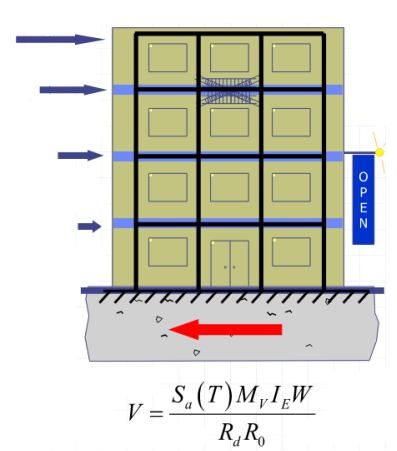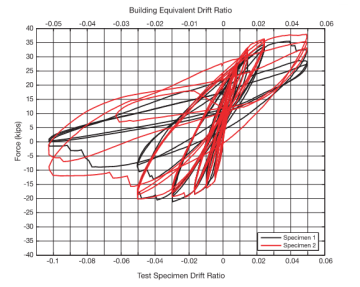What is Performance-Based Design?
A brief comparison of traditional and performance-based design approaches in structural engineering, exploring how performance-based methods can lead to more efficient and reliable building designs.
 In traditional code-based design, we tend to follow a process similar to this:
In traditional code-based design, we tend to follow a process similar to this:
- Select a structural system and look up its code-defined characteristics
- Look up the site seismicity from a table to define a response spectrum at our design hazard
- Preliminarily scheme the structural system and size elements
- Calculate the design base shear
- Apply the code prescribed forces to the structure with a static or linear dynamic analysis.
- Check building drifts and strengths of the structural members
- Detail the structural members
Its (usually) pretty straight-forward, and generally produces designs that meet the life-safety performance objective. But there is an implicit assumption in that procedure. The assumption is that, if you use a code-prescribed system with its corresponding properties and detailing, you will meet the performance objective of collapse prevention at the required seismic hazard (typically 2% probability of exceedance in 50 years or 1/2475 return period). This isn't actually checked in a code-based design. Performance isn't actually measured. A given set of buildings can all be designed to meet code, and yet have very different performance.
In performance-based design, we flip that concept around. Instead of relying on the building code to come up with a 'recipe' for achieving the desired performance, we start by defining the characteristics of the building and structural elements at our desired performance. We might say, for instance, that the building drift shouldn't exceed 2.5%, and our wall shear stress should be less than 10sqrt(fc), and our coupling beams shouldn't rotate more than 6%, and so on for all the different elements we are concerned about.
Perhaps we even add more than the code requires - we could think about performance at frequent, lower intensity earthquakes, as well as rare, intense earthquakes, and come up with criteria for both. Or we could use new innovative structures that aren't in the code yet. Or we could just show that certain aspects of the code are not required to achieve code-equivalent performance. That last item is actually what really gave rise to performance-based design in the west coast of the United States.
You see, ASCE 7 has this requirement, stemming from way back, that buildings over 240 feet must contain a complete moment resisting space frame. That is quite expensive, and prohibits the shear wall buildings with flat plate floor slabs that are so common in the rest of the world, from going higher than about 20 stories. So, the way around that is clear. We can show that the performance of the building without the moment frame still achieves equivalent performance to the building code. And we do that by utilizing state-of-the-art analysis software and simulating the full nonlinear response of strcutural elements. The analysis procedure is informed by phsyical tests of structural elements and subsystems, so we know both how the elements crack, deform, and degrade, and also how far they can be pushed before failure. Because there is so much more in-depth study being undertaken, the performance-based design route typically employs a Peer Review team of experts to oversee the modelling and design.

Various guidelines have been developed to help define a common set of best practices for the implementation of performance-based design. These include the Los Angeles Tall Building Seismic Design Council guidelines and PEER Tall Building Initiative guidelines.
The first step in performance-based design is to use the guidelines, experience, test data, and local regulations from the Authority Having Jurisdiction, to develop a project-specific design criteria that can be reviewed and approved by the Peer Review Panel. This sets out how the project deviates from the code, how the building will be analyzed, and how performance will be measured (ie what are the performance objectives).
After that, the design team comes up with a structure that they think will meet those objectives, documents the intial design approach, and builds the advanced nonlinear model. That model is subjected to representative earthquake ground motions and the behavior of the structural components is analyzed. The performance objectives are compared to the earthquake demands, and the design is fine-tuned to satisfy all objectives.
-Jeremy
Jeremy Atkinson
Jeremy is a structural engineer, researcher, and developer from BC. He works on Calcs.app and writes at Kinson.io